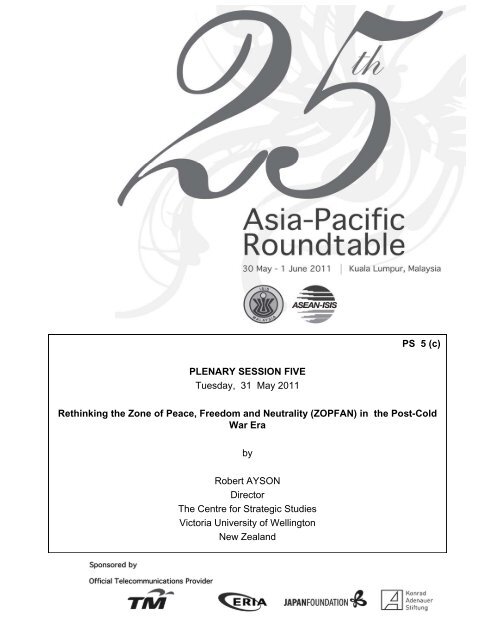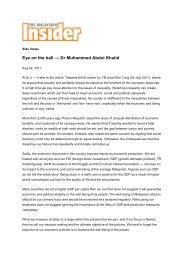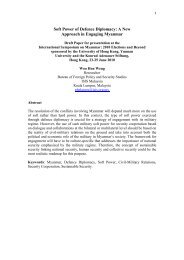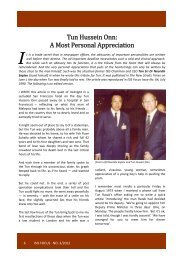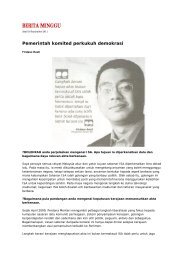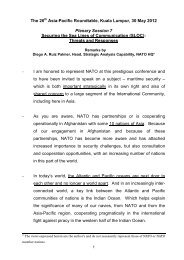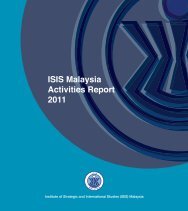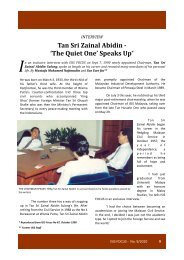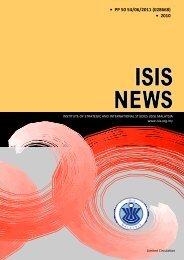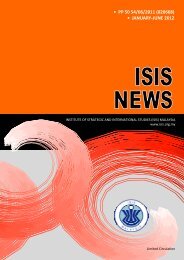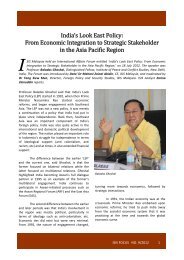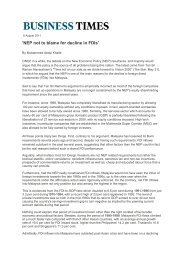ZOPFAN - ISIS Malaysia
ZOPFAN - ISIS Malaysia
ZOPFAN - ISIS Malaysia
Create successful ePaper yourself
Turn your PDF publications into a flip-book with our unique Google optimized e-Paper software.
PS 5 (c)<br />
PLENARY SESSION FIVE<br />
Tuesday, 31 May 2011<br />
Rethinking the Zone of Peace, Freedom and Neutrality (<strong>ZOPFAN</strong>) in the Post-Cold<br />
War Era<br />
by<br />
Robert AYSON<br />
Director<br />
The Centre for Strategic Studies<br />
Victoria University of Wellington<br />
New Zealand
Rethinking the Zone of Peace Freedom and Neutrality (<strong>ZOPFAN</strong>)<br />
in the PostCold War Era<br />
Paper for 25 th AsiaPacific Roundtable<br />
Kuala Lumpur, <strong>Malaysia</strong>, 31 May 2011<br />
Robert Ayson, Victoria University of Wellington, New Zealand<br />
<strong>ZOPFAN</strong> does not have an image problem. It has two image problems. First,<br />
many well‐informed people have either not heard of the Zone of Peace Freedom<br />
of Neutrality, or did so some time ago and have since forgotten about it. Second,<br />
there is a smaller group of people who are aware of <strong>ZOPFAN</strong> but who tend to<br />
discount its significance and impact. They are often skeptical and cynical about<br />
<strong>ZOPFAN</strong> and regard it as little more than empty symbolism.<br />
But there are also those who think <strong>ZOPFAN</strong> is worthy of closer and more serious<br />
consideration, and quite a few of these people are concentrated in regional<br />
gatherings such as the Asia‐Pacific Roundtable. Rather to my surprise, I would<br />
like to side with this minority view. I don’t think it is wise to claim that the 1971<br />
Kuala Lumpur Declaration is the key to the development of an Asian security<br />
community, and I think that community is some way off. But <strong>ZOPFAN</strong> is part of<br />
the fabric of norms which press for restraint on divisive behavior in the region –<br />
by the Southeast Asian countries and external powers alike. The Declaration<br />
represents a compromise between the differing positions which were being<br />
adopted by some of the members of ASEAN, who as a much smaller and younger<br />
grouping than we see today, were still feeling their way. Without such<br />
compromises, these different positions might otherwise have proven more<br />
divisive.<br />
That said, it would be ambitious to conclude that the Southeast Asian countries<br />
and the great powers have fully or continuously reflected the spirit of what is<br />
actually a rather undemanding Declaration in the forty years since its signature<br />
here in Kuala Lumpur. But there is still something about the <strong>ZOPFAN</strong> experience<br />
which encourages us to ask some fairly important questions about regional<br />
relationships in 2011 and beyond.<br />
<strong>ZOPFAN</strong> and the Great Powers<br />
The establishment and the experience of <strong>ZOPFAN</strong> speaks to an issue which is<br />
very pertinent to today’s observers of regional affairs: Southeast Asia’s relations<br />
with the great powers. The <strong>ZOPFAN</strong> Declaration emerged during a period when<br />
the great power balance in wider Asia was shifting. Concerns were arising that<br />
competition in Asia between the great powers could reduce the capacity of the<br />
ASEAN countries, some of whom had been independent sovereign states for a<br />
relatively brief period, to pursue their interests in important processes of<br />
national political, social and economic development.
A multitude of interacting adjustments were part of this changing external<br />
picture: the disappearance of Britain as a significant factor in regional power<br />
politics, the reduction in America’s commitment to ground wars in Asia in light of<br />
its difficult experience in Vietnam, the increasing strength of both the Soviet<br />
Union and China, and concerns about coming influence of Vietnam, the largest<br />
Southeast Asian power outside of ASEAN at that time.<br />
Relations between the great powers themselves were in a genuine state of flux.<br />
This was an era of significant tension between the Soviet Union and China. The<br />
two fought a seven month border war in 1969 and were not united in their<br />
attitudes towards the conflict which was still occurring in mainland Southeast<br />
Asia. This was also an era of superpower détente, but the improvement in US‐<br />
Soviet relations had more benefit for Europe than it did for Asia. While this was<br />
also the era of the grand rapprochement between the United States and China,<br />
that improvement in great power relations could have unintended consequences<br />
for some Southeast Asian capitals. Would this Sino‐American understanding<br />
mean greater influence in this part of the world for China, known for supporting<br />
insurgencies in the region and subjecting itself to the Cultural Revolution<br />
Three Options<br />
In these challenging, fluid and uncertain external circumstances, there were at<br />
least three options open to ASEAN’s policy‐makers. The first was to acknowledge<br />
that while the great powers did indeed play a part in the affairs of the region,<br />
assurances needed to be sought from them that they would not use Southeast<br />
Asia as their plaything by playing the game of divide a rule. This meant not acting<br />
in such ways as to encourage the Southeast Asian countries to take sides. Here<br />
the Southeast Asian nations would themselves need to investigate their own<br />
strategic relations with any one of the great powers to ensure that they were not<br />
sustaining the competitive juices of the other big players.<br />
Into this first category we might put <strong>Malaysia</strong>’s thinking about neutralization in<br />
the late 1960s including the proposal which was submitted to the Lusaka<br />
meeting of the Non‐Aligned Movement in 1970. This was a call for a real and<br />
robust zone where the great powers would in a sense neutralize themselves.<br />
While on the surface this would seem to be an even‐handed gesture, treating the<br />
great powers equally, proposals of this sort tend to redound to the different<br />
interests of the great powers in an uneven way. Great power neutralization<br />
would probably have done more to restrain the two superpowers, and the<br />
intrusion of their East‐West competition, and it would especially have reduced<br />
the role of the United States, the more active of these two in developing strategic<br />
relationships across Southeast Asia. It would and have done rather less to curtail<br />
China, the up and coming power. Indeed some scholars have argued that for<br />
<strong>Malaysia</strong>, which was experiencing some challenging inter‐communal<br />
circumstances domestically, the proposal for neutralization might have been<br />
aimed partly as a means of developing an understanding with China.<br />
The second option also acknowledges that the attitudes taken by the great<br />
powers are crucial to Southeast Asia’s security. But rather than seeking from<br />
2
them an assurance of fair play which restricts their competitive power‐plays in<br />
the region, one seeks to encourage an equilibrium of power between them as the<br />
multiple big players, so that the power of each one balances the influence of the<br />
others. This vigilantly watched and continually adjusting equilibrium might<br />
perhaps buy the ASEAN countries (and other smaller powers in the region) some<br />
valuable time, and allow them to avoid the nasty choices between rival big<br />
powers.<br />
This is familiar in the thinking we have come to see from Singapore in particular,<br />
but it has also some currency in today’s thinking in Indonesia, Vietnam and<br />
elsewhere. Back in the early 1970s this logic would have appealed to those who<br />
felt that it was in the interests of the Southeast Asian region for significant<br />
connections to be retained with the United States including the formal alliance<br />
with Washington that were maintained by two members of the original ASEAN<br />
five.<br />
That US connection suggests that such an equilibrium would not necessarily<br />
affect the interests and roles of the great powers evenly. Whereas proposals for<br />
neutralization can favour the rising power, those with an equilibrium in mind<br />
tend to privilege the established ones.<br />
But there are still various interpretations of what an Asian equilibrium might<br />
involve and why one might be necessary. In this same period the Australian<br />
scholar Hedley Bull was touting the idea of a four‐way great power equilibrium<br />
in Asia. Sensing a major change in the regional distribution of power which<br />
featured a chastened United States and a more prominent China, Bull argued that<br />
Australia’s security could no longer depend so strongly as it had done on the US<br />
alliance. Instead it needed to rest upon a four way equilibrium between the<br />
United States, the Soviet Union, China and Japan. This meant, for example, that<br />
Australia should welcome the Soviet Union’s regional role as a way of balancing<br />
China’s, although Bull was also quick to point out that China also had a legitimate<br />
place at Asia’s great power table, even if it was going through tumultuous times.<br />
And while he foresaw a diminished role for the United States in the region, (a<br />
forecast that has been made rather too often) he did not suggest that American<br />
would disappear as a major factor. It was now, however, one of many.<br />
The third and potentially most radical option is the refusal to accept that<br />
Southeast Asia’s security should depend on the great powers, either by getting<br />
them to restrain their own behaviour or each other’s behaviour through an<br />
equilibrium. This is the argument that the region would be better without the<br />
great powers, and that Southeast Asia should be left to produce its own security.<br />
This thinking appealed to Jakarta and helped propel Indonesia’s opposition to<br />
the original <strong>Malaysia</strong>n proposal which preceded the 1971 Kuala Lumpur<br />
compromise.<br />
In its purest form of this self‐sufficient logic would have required many of nonaligned<br />
Indonesia’s more aligned neighbours in Southeast Asia to jettison their<br />
strategic relationships with outside powers. It would probably have required the<br />
Philippines and Thailand to end their alliance relationships with the United<br />
3
States which were by then nearly three decades old. It would have meant the<br />
dissolution of the South East Asia Treaty Organization a few years before its<br />
eventual demise in the mid‐1970s upon the reunification of Vietnam. It would<br />
probably have argued against the Five Power Defence Arrangements (FPDA).<br />
Also emerging in 1971, the FPDA were welcomed by their two Southeast Asian<br />
signatories, <strong>Malaysia</strong> and Singapore, who stood to gain as beneficiaries of ther<br />
relations with the three external members, the United Kingdom, Australia and<br />
New Zealand. But while a good deal softer than Britain’s earlier alliance<br />
commitments in Southeast Asia, the FPDA was still not warmly welcomed by<br />
Indonesia.<br />
This third approach, which might be called strategic autarky, would also have<br />
had an uneven result on the great power picture. It would have further reduced<br />
the already declining Western influence in Southeast Asia: Britain and the United<br />
States were the main external security partners for a number of the ASEAN<br />
countries, and indeed among the five only Indonesia lacked such a connection.<br />
Presumably the Soviet Union would have also been required to cease its<br />
assistance to Vietnam, but the latter was not yet a member of ASEAN, nor was it a<br />
signatory to its declarations. Removing the great power linkage and presence<br />
might also have changed the delicate balance of power within ASEAN, with<br />
<strong>Malaysia</strong> and Singapore given extra reasons to be conscious of Indonesia’s size<br />
and also to be concerned about each other’s intentions. Indeed one of the main<br />
benefits of the FPDA has been to encourage Singapore and <strong>Malaysia</strong> to maintain<br />
a relationship of peaceful co‐existence.<br />
The <strong>ZOPFAN</strong> Compromise<br />
The <strong>ZOPFAN</strong> Declaration reflects the tradition of ASEAN decision‐making where<br />
compromises emerge from the different interests that its members bring to the<br />
table. Critics may deride the lowest common denominator approach this can<br />
produce, and the 1971 <strong>ZOPFAN</strong> Declaration is an example of this tradition, but<br />
such pragmatic standards of behaviour have helped keep ASEAN afloat. They are<br />
not without their wisdom and in many instances have served the region well.<br />
Accordingly the Kuala Lumpur Declaration does not demand immediate<br />
neutralization. The ‘n’ word does not appear in the two brief operative clauses<br />
which conclude the Declaration. Instead the preamble which indicates that ‘the<br />
neutralization of South East Asia is a desirable objective and that we should<br />
explore ways and means of bringing about its realization.’ The language in the<br />
operative clauses is more closely linked to the spirit of ASEAN’s 1967 foundation<br />
document, committing the five signatories to work to be ‘free from any form or<br />
manner of interference by outside Powers.’<br />
Rather than a concerted attempt at neutralization per se, there is a more general<br />
(and some might say vaguer) recognition of the interests of ASEAN’s members in<br />
conducting their affairs in a space which is less aggravated and crowded by great<br />
power competition. The emphasis on freedom from interference is reminiscent<br />
of earlier concerns with the possibility of external support for local insurgencies,<br />
a challenge which helped shape the original aims of ASEAN. But the Declaration<br />
4
makes no mention at all of external powers. The conspicuous silence on this vital<br />
point suggests that while <strong>Malaysia</strong>’s plans for gaining assurances of restraint<br />
from the great powers had not been satisfied, neither had Indonesia’s interests in<br />
the ending of security partnerships by its ASEAN neighbours with great power<br />
protectors.<br />
Taking a Deeper Look<br />
The ability that ASEAN countries have since had to maintain alliance and nearalliance<br />
relations with great power friends, may explain some of the skepticism<br />
directed towards the Declaration. But this attitude may be out of keeping with<br />
what the Declaration says, setting expectations higher than what was agreed in<br />
Kuala Lumpur forty years ago. And <strong>ZOPFAN</strong> emphasizes the other part of the<br />
story: the building by the ASEAN countries of their own cooperative<br />
relationships. One of the Declaration’s operative clauses commits the ASEAN<br />
signatories to “make concerted efforts to broaden the areas of cooperation which<br />
would contribute to their strength, solidarity and closer relationship." This is not<br />
about finding security through the perfection of great power conduct. It is about<br />
building up ASEAN’s own capacity to develop order in Southeast Asia. This gives<br />
some strength to Indonesia’s position on what now might be called ASEAN<br />
centrality.<br />
Some of the Declaration’s other features also foreshadow ASEAN initiatives<br />
which were to come in later years. The preamble notes with approval the<br />
establishment of nuclear weapon free zones in other parts of the world,<br />
something which would later come to this region in the form of the Southeast<br />
Asian Nuclear Weapons Free Zone. The Declaration also notes the importance of<br />
the peaceful resolution of disputes as a clear expectation of interstate behaviour<br />
endorsed by the United Nations. This theme is also reflected in the subsequent<br />
Treaty of Amity and Cooperation (TAC).<br />
Indeed <strong>ZOPFAN</strong> was overtaken and hidden by the TAC and other later products<br />
of Southeast Asian diplomacy, one reason perhaps for its low profile. But it is still<br />
part of the fabric of ASEAN’s normative endeavours. This is so even if the idea of<br />
a zone of peace freedom and neutrality is not entirely in keeping with the type of<br />
geopolitical reasoning that was entertained in a number of ASEAN capitals when<br />
Vietnam invaded Cambodia in the mid‐1970s and which led some of them to<br />
view China as a regional balancer.<br />
This normative fabric still has its limits today in light of the realities of modern<br />
diplomacy in Southeast Asian. These limits come into play when we consider<br />
whether <strong>ZOPFAN</strong> and subsequent declarations and initiatives really underwrite<br />
aspirations within ASEAN for the establishment of a security community. To<br />
achieve this lofty objective one would need to confirm that the use of armed<br />
violence had become unthinkable as a way of settling disputes within that<br />
community, as had preparations to do so including the competition in<br />
armaments. Such a security community is still a glint in the eye in this part of the<br />
world and efforts to suggest otherwise may encourage further cynicism. The<br />
recent, albeit, limited scuffle between Thailand and Cambodia is but one piece of<br />
5
data which call into question that probability. And while a number of the<br />
Southeast Asian claimants in the South China Sea have reasons to be concerned<br />
about China’s approach in recent times, wouldn’t a security community mean<br />
that they would need to guarantee that in their relations with one another as<br />
fellow members of ASEAN they could guarantee peaceful behaviour<br />
The Rise of the Second Option: Equilibrium<br />
In 2011, few ASEAN countries, and few of their regional partners, including<br />
Australia and New Zealand, are taking active steps to build a zone of neutrality.<br />
None of them, from what I can see, are seeking to unwind their existing<br />
connections to outside powers. While there is an interest in peace and freedom,<br />
there is little appetite for the idea that the great powers can somehow be kept<br />
out of Southeast Asia’s affairs. If anything there is a desire to strengthen their<br />
involvement. This is happening in at least three ways.<br />
First, Southeast Asia is home to a number of thriving economies which would be<br />
wasting away were it not for their trade and investment connections with the<br />
major Asia‐Pacific powers. At the forefront here are a series of increasingly<br />
intense economic relations with China, which certainly did not exist in 1971<br />
when the <strong>ZOPFAN</strong> Declaration was signed (years before Deng declared that it<br />
was good to be rich). Depending as they do upon China’s continuing growth for a<br />
good deal of their own prosperity, the Southeast Asian countries would be<br />
unable to countenance any move towards disengagement with China, at least<br />
economically. That so many of the members of ASEAN also enjoy beneficial<br />
economic interactions with the United States and Japan, and increasingly with<br />
India, also strikes a blow to the idea of keeping the great powers out of the<br />
picture (the main restraint that might be sought from them is the avoidance of<br />
trade barriers rather than any commitment to neutralization).<br />
For New Zealand and Australia the picture is very similar: our economic future<br />
depends heavily on the success of our engagement with the great Asia‐Pacific<br />
economies. While Australia’s reliance on its East Asian economic connections is<br />
stronger than New Zealand’s, Australia’s resources boom has helped drive<br />
transTasman trade which keeps New Zealand’s economy ticking over.<br />
Second, many Southeast Asian countries, both alone and together, have an<br />
interest in a balance of military power between the major players who they<br />
realize are not going to be going way in security terms. In fact as Asia’s economic<br />
giants increase their ability to project military power and exert their interests in<br />
maritime Southeast Asia ‐ the gateway between the Indian and Pacific Oceans ‐<br />
the prospects of keeping the region free from great power strategic activity and<br />
competition are receding rather than increasing. Rather than keeping the great<br />
powers out, keeping them in together to balance each other’s power seems to be<br />
an increasingly common approach.<br />
With Japan less confident than its substantial economic base and military<br />
potential would suggest, and India still coming onto the scene, this often boils<br />
down to the management of the China‐US strategic balance. And the long‐term<br />
6
trend in relative power appears to be in China’s favour. As China slowly closes<br />
the gap with the US, we should not expect that amongst many Southeast Asian<br />
countries the appeal of an American strategic connection with the region, formal<br />
or informal, will disappear.<br />
That appeal could get stronger. Supposedly outdated alliance relationships with<br />
Washington are still valued, (and increasingly so by the Philippines). The port<br />
facilities offered by Singapore also encourage a continuing American presence in<br />
the region. The FPDA is valued partly because two of its external members,<br />
Australia and the United Kingdom, also have such close alliance relationships<br />
with Washington. But it is not all about the United States. The closer security<br />
relations that some Southeast Asian governments have been building with India,<br />
Asia’s second rising power, are also part of the quest for a military equilibrium.<br />
And so too is the cooperative interaction between a number of Southeast Asian<br />
countries and the People’s Liberation Army which is also likely to steadily<br />
increase.<br />
The pattern in Australia and New Zealand’s relationships with the larger powers<br />
is not altogether dissimilar. Australia’s economic, diplomatic and military<br />
interaction with China has increased but not at the expense of a very close<br />
strategic relationship with Washington and the signing of security declarations<br />
with both Japan and India. New Zealand has a closer security relationship (but<br />
not a full alliance) with the United States alongside its very important with China<br />
with whom it has a highly valued Free Trade Agreement. The 2010 Defence<br />
White Paper included New Zealand’s obligations to the FPDA as one of the<br />
conditions in which it might consider the use of force.<br />
Third, the simultaneous engagement of the major powers is a cardinal feature of<br />
the regional multilateral architecture, much of which is still centred on ASEAN.<br />
Some of that architecture has a more exclusively East Asian feel which tends to<br />
recognise the obvious importance of China’s regional place: ASEAN+3 is the<br />
paramount example here. But a number of Southeast Asian governments have<br />
also been very keen to see the closer multilateral engagement of the United<br />
States including in the expanded East Asia Summit and the Asian Defence<br />
Ministers Meeting Plus arrangement. New Zealand and Australia have also given<br />
strong support to this development. India’s place in this consolidated regional<br />
membership of 18 countries (which also include China, Japan, and Russia) is also<br />
part of the attempt to build in some extra ballast in a multi‐party equilibrium.<br />
These three areas of regional relationships involving the great powers –<br />
economic, strategic and diplomatic – all appear to be heading in the same<br />
direction. Most of the members of ASEAN, and many of their medium and small<br />
power partners (including Australia and New Zealand) are seeking to involve<br />
and engage the great powers simultaneously in the hope that some sort of<br />
equilibrium between them can create a space in which peace and prosperity<br />
flourish. New Zealand’s Prime Minister John Key said last year in a major speech<br />
that he was comfortable with the prospect of two superpowers in the region –<br />
implying that China could join the United States in that rarified status. Like many<br />
others New Zealand is seeking to work with the giants simultaneously: the White<br />
7
Paper welcomes the US presence in the region at the same time as it<br />
acknowledges the legitimacy of China’s place as a rising power.<br />
Back to the Future<br />
Many of the features of today’s regional environment hark back to the era which<br />
brought us the <strong>ZOPFAN</strong> Declaration in 1971. Great power relations are in a state<br />
of significant change as China rises, India does so at a slower place, and Japan<br />
and the United States seek to respond (with Soviet Russia out and India in maybe<br />
Bull’s quadrilateral equilibrium has something going for it). And there are the<br />
concerns about what the great powers may do. On the one hand there is concern<br />
that increased great power competition may increasingly find its way into<br />
Southeast Asia. On the other there have been concerns about America’s relative<br />
decline and attempts to encourage its continuing engagement as a regional<br />
balancer.<br />
But this time around, partly thanks to the new multilateral mechanisms which<br />
have emerged in more recent years, ASEAN is (organizationally at least) at the<br />
centre of attempts to build beneficial relationships of engagement with the great<br />
powers. In this century, as global power shifts increasingly in Asia’s direction,<br />
even modest contributions to these relationships can have international<br />
significance.<br />
As a modest achievement, <strong>ZOPFAN</strong> might not quite be at the forefront of these<br />
efforts. And there is little enthusiasm for neutralization or non‐alignment: that<br />
other option, the search for an equilibrium between engaged powers, seems to<br />
be king. But one is still encouraged to wonder what a Declaration of the <strong>ZOPFAN</strong><br />
family might look like if there were attempts to establish it in 2011.<br />
It probably would not be a Zone of Peace, Freedom and Neutrality. But there<br />
might be room for ZOPFAR: a Zone of Peace, Freedom and Restraint Why<br />
restraint and not neutrality Might we call on the great powers to consider the<br />
mutual benefits that would arise if they restrained their conventional military<br />
practices before their competition with one another and their interactions with<br />
some of Southeast Asia’s countries get too heated Could we see the South China<br />
Sea itself as a Zone of Restraint Progress on multilateral incidents at sea<br />
arrangements would also seem to be in order. But in the meantime a fair bit of<br />
unilateral restraint, which is the real core of arms control as Hedley Bull argued<br />
all those years ago, would help too. ASEAN and its partners do not want to, nor<br />
can we afford to, exclude the great powers. But we do need them to play by a set<br />
of good rules. Finding rules that will appeal to all the big powers is part of the<br />
challenge.<br />
* * *<br />
8


